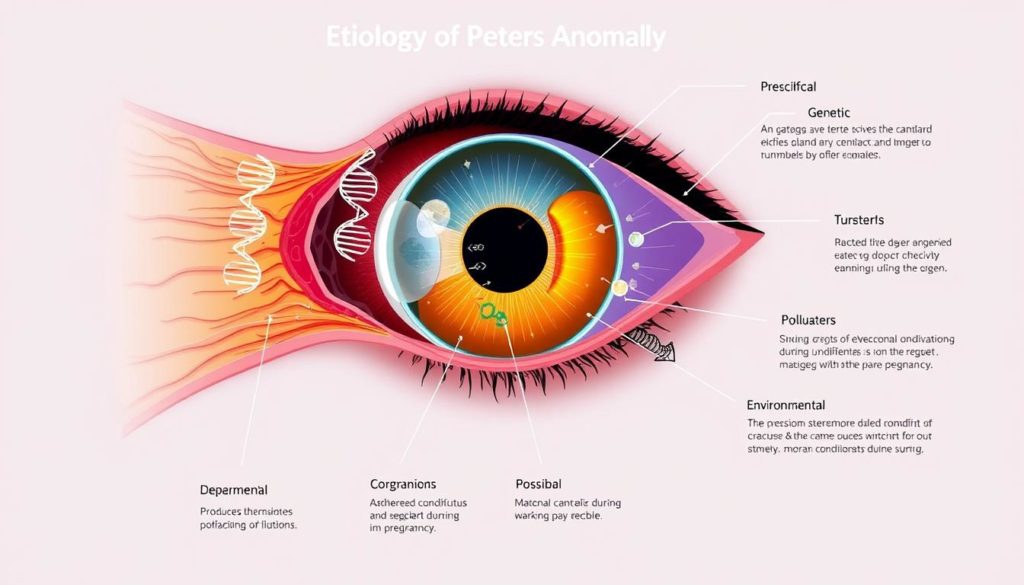“The only real voyage of discovery consists not in seeking new landscapes, but in having new eyes.” – Marcel Proust
Peters Anomaly is a rare eye disorder that fits Proust’s words perfectly. This guide aims to explain Peters Anomaly in detail. It covers what it is, why it happens, its symptoms, and how to treat it.
Whether you’re a patient, a family member, or a healthcare worker, this guide is for you. It offers important information to help manage and understand Peters Anomaly.
What is Peters Anomaly?
Peters Anomaly is a rare condition found at birth. It causes a central corneal opacity. This condition often comes with other eye problems, like adhesions between the cornea and the iris. Knowing about Peters Anomaly is key for the right diagnosis and treatment.
Defining Peters Anomaly
Peters Anomaly definition mentions a central corneal opacity at birth. These opacities can block vision and are often linked to other eye issues. The condition can also include adhesions between the cornea and the iris, making it more complex.

The History and Discovery of Peters Anomaly
Peters Anomaly has been studied since the early 1900s. Medical experts have worked hard to understand its causes and effects. Their research has helped us learn how to manage and treat this condition better today.
Causes of Peters Anomaly
Peters Anomaly is a complex eye condition. Researchers are still trying to figure out what causes it. They have found that both genetics and the environment play a role.
Genetic Factors
Genes like PAX6 and PITX2 are linked to Peters Anomaly. These genes are important for eye development. When they mutate, it can lead to Peters Anomaly.
Scientists are working hard to learn more. They hope to find new ways to treat it.
Environmental Factors
Genetics aren’t the only thing that matters. What happens before a baby is born can also affect their eyes. This includes things like what the mother eats and her exposure to toxins.
These environmental factors are not as well understood. But researchers are studying them closely. They want to know how they impact eye health.

Symptoms and Identification of Peters Anomaly
Finding Peters Anomaly early in infants is key for better vision. Spotting symptoms early leads to quicker treatment.
Early Signs in Infants
Parents and doctors need to watch for signs of vision problems in newborns. Look out for:
- Cloudy corneas
- Visible eye irregularities
- Abnormal eye movements
Diagnostic Procedures
When signs appear, it’s time for eye tests to confirm the issue. Important tests include:
Eye exams are crucial for early detection. They might include:
- Slit-lamp examination
- Genetic testing to find family links
- Ultrasound biomicroscopy for detailed eye views
These tests help get a clear diagnosis. This leads to the right treatment plan early on.
| Procedure | Purpose | Importance |
|---|---|---|
| Slit-lamp Examination | Examines the clear part of the eye | Detects cloudiness or irregularities in the cornea |
| Genetic Testing | Identifies genetic anomalies | Confirms familial links to Peters Anomaly |
| Ultrasound Biomicroscopy | Provides detailed images of internal structures | Ensures thorough evaluation of anatomical irregularities |
Impact of Peters Anomaly on Vision
Peters Anomaly can greatly affect vision, causing different levels of visual loss. It’s important to understand these effects to manage the condition and keep eyes healthy.
Degrees of Visual Impairment
The vision loss from Peters Anomaly can vary. It can range from partial blindness to complete loss of sight. The severity depends on the eye’s specific problems, like cornea clouding or issues in the eye’s front part.
Long-term Effects on Eye Health
Peters Anomaly can have lasting effects on eye health. Glaucoma is a common issue for those with this condition. Regular check-ups by pediatric ophthalmologists are key to managing these problems and improving patient outcomes.
Treatment Options for Peters Anomaly
Managing Peters Anomaly requires a mix of treatments. This includes both non-surgical and surgical options. Each patient’s needs are unique, so a tailored approach is key.
Non-surgical Treatments
At first, non-surgical treatments are crucial. Corrective lenses help improve vision and reduce symptoms. Sometimes, eye drops are used to fight inflammation.
Surgical Interventions
For serious cases, surgery is needed. A common procedure is the corneal transplant. This eye surgery replaces the damaged cornea with a healthy one. It greatly improves vision and quality of life.
Pediatric ophthalmologists make sure these surgeries fit children’s needs. They aim for high success rates and quick recovery times.
The right treatment depends on many factors. These include the patient’s age, how severe the anomaly is, and their eye health. Regular check-ups with a pediatric ophthalmologist are important. They help track progress and adjust the treatment plan as needed.
Advances in Corneal Transplant Procedures
New developments in corneal transplants have changed ophthalmology. They offer better results and faster recovery for patients. Let’s look at the key advancements in surgery and how they affect success and recovery.
New Techniques in Corneal Transplants
New corneal transplant innovations include Endothelial Keratoplasty (EK) and Descemet Stripping Endothelial Keratoplasty (DSEK). These methods make surgeries more precise and quick. They use less donor tissue, which helps the graft stick better and lowers rejection chances.
Another method, Anterior Lamellar Keratoplasty (ALK), is becoming popular. It replaces just the front part of the cornea. This keeps more of the patient’s natural eye tissue.
Success Rates and Recovery
Today, eye surgery success rates are much higher. This is thanks to careful surgery and better care after surgery. Surgeons use advanced imaging for accurate graft placement. They also use new medicines to reduce inflammation and prevent infection.
Custom recovery plans are also key. They include detailed instructions for postoperative recovery in ophthalmology. These plans help prevent complications and speed up healing.
- Regular follow-ups to monitor graft health
- Use of anti-rejection medications
- Protective eyewear to prevent injury
These steps greatly improve the success and lasting effects of corneal transplants. They give patients a brighter, clearer future.
The Role of Pediatric Ophthalmology in Managing Peters Anomaly
Pediatric ophthalmologists play a key role in keeping the eyes of children with Peters Anomaly healthy. This condition, marked by cloudy corneas, needs special care. These doctors are experts in diagnosing and treating Peters Anomaly, helping families a lot.
Managing Peters Anomaly is not just about the first diagnosis. It’s about ongoing care as the child grows. Pediatric ophthalmologists keep an eye on the child’s vision, changing treatments as needed. This approach helps tackle any new problems with the condition.
Some important tasks for pediatric ophthalmologists with Peters Anomaly include:
- Early Diagnosis: Finding signs of Peters Anomaly early is key for quick action.
- Customized Treatment Plans: Each child might need a special mix of treatments, like surgery or other options.
- Ongoing Monitoring: Regular visits help catch any changes in the child’s condition, protecting their vision and eye health.
Parents and pediatric ophthalmologists must work together to manage Peters Anomaly. This partnership helps create detailed treatment plans. Together, they can greatly improve the lives of children with this condition.
Resources and Support for Families
For families dealing with Peters Anomaly, finding reliable resources and support is key. Connecting with experts and support groups offers the help families need.
Finding Specialists
Finding eye specialists who know how to treat Peters Anomaly is a first step. These doctors guide families through tests and suggest the best treatments.
| Resource | Description |
|---|---|
| Pediatric Ophthalmologists | Specialize in eye conditions affecting children, providing expert care and advice. |
| Corneal Specialists | Focus on disorders of the cornea, often offering surgical solutions for advanced cases. |
| Genetic Counselors | Help families understand the genetic factors involved and the risks for future children. |
Support Groups and Communities
Joining ocular disorder communities can really help families cope. These groups offer emotional support and share advice and experiences.
Families find comfort and strength in connecting with others who get it. Using these resources helps families deal with Peters Anomaly more easily and confidently.
Living with Peters Anomaly: Patient Stories
Personal stories about Peters Anomaly offer a deep look into daily struggles and victories. These tales show how living with vision loss affects education, work, and social life.
Melissa was diagnosed early and faced many challenges. She says, “Adapting to school life was tough, but with the right support and dedication, I excelled academically.” Her story shows how Peters Anomaly can shape personal growth and resilience.
Kevin’s story is another powerful example. Despite Peters Anomaly, he became a successful software developer. He credits technology and a supportive work environment for his success. “I never let my condition define my capabilities,” Kevin says, showing the importance of resilience.
These stories show not just the struggles but also the victories. They prove the human spirit can overcome tough challenges. Their tales inspire hope, showing that living with Peters Anomaly is about finding strength in adversity.
“It’s not about the challenges we face, but how we rise to meet them that defines our journey,” Melissa states, reflecting on her personal experiences with Peters Anomaly.
These compelling stories underline the value of community and support. Coping with vision loss is hard, but these stories show it’s possible with determination and the right help.
Conclusion
Understanding Peters Anomaly is key to managing it well. This guide has covered many topics, from its history to the latest treatments. Spotting early signs and getting a quick diagnosis can make a big difference.
Genetics and the environment both affect it. Knowing this helps families get the right care. This knowledge is powerful.
The effect on vision can change, but new treatments have helped a lot. Now, there are many ways to treat it, from non-surgical to surgical options. Each person gets a plan that fits their needs.
Support for eye health is also crucial. There are many resources and communities to help families. Together, medical progress and support give people with Peters Anomaly a chance at a good life.
As research keeps going, the future looks bright. There’s hope for even better care and outcomes.
FAQ
What is Peters Anomaly?
Peters Anomaly is a rare eye disorder present at birth. It causes corneal opacity and other eye issues. It can affect one or both eyes and varies in severity.
What are the causes of Peters Anomaly?
Genetics play a big role in Peters Anomaly, with genes like PAX6 and PITX2 involved. Research also looks into how the environment affects eye health.
How can Peters Anomaly be identified in infants?
Early signs include cloudy corneas or eye irregularities. Doctors use eye exams, genetic tests, and ultrasound biomicroscopy for diagnosis.
What impact does Peters Anomaly have on vision?
Vision can be partially impaired or completely lost. It can lead to glaucoma, requiring ongoing care.
What treatment options are available for Peters Anomaly?
Treatments include corrective lenses and corneal transplants. The choice depends on the condition’s severity and the patient’s needs.
Are there advances in corneal transplant procedures for Peters Anomaly?
Yes, new transplant techniques have improved success rates. Proper recovery is key to maintaining eye health.
How does pediatric ophthalmology help in managing Peters Anomaly?
Pediatric ophthalmologists diagnose, treat, and monitor Peters Anomaly. They provide specialized care for children with this condition.
Where can families find support and resources for managing Peters Anomaly?
Families can find support from specialists, support groups, and online communities. These resources offer emotional support and practical advice.
Are there any patient stories about living with Peters Anomaly?
Yes, many share their experiences with Peters Anomaly. Their stories offer insights and inspiration to others facing similar challenges.


